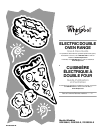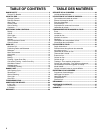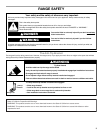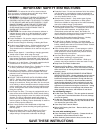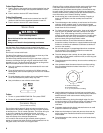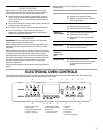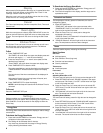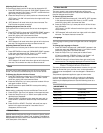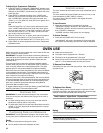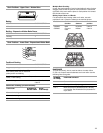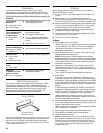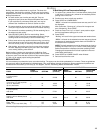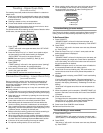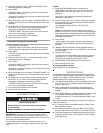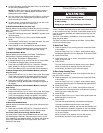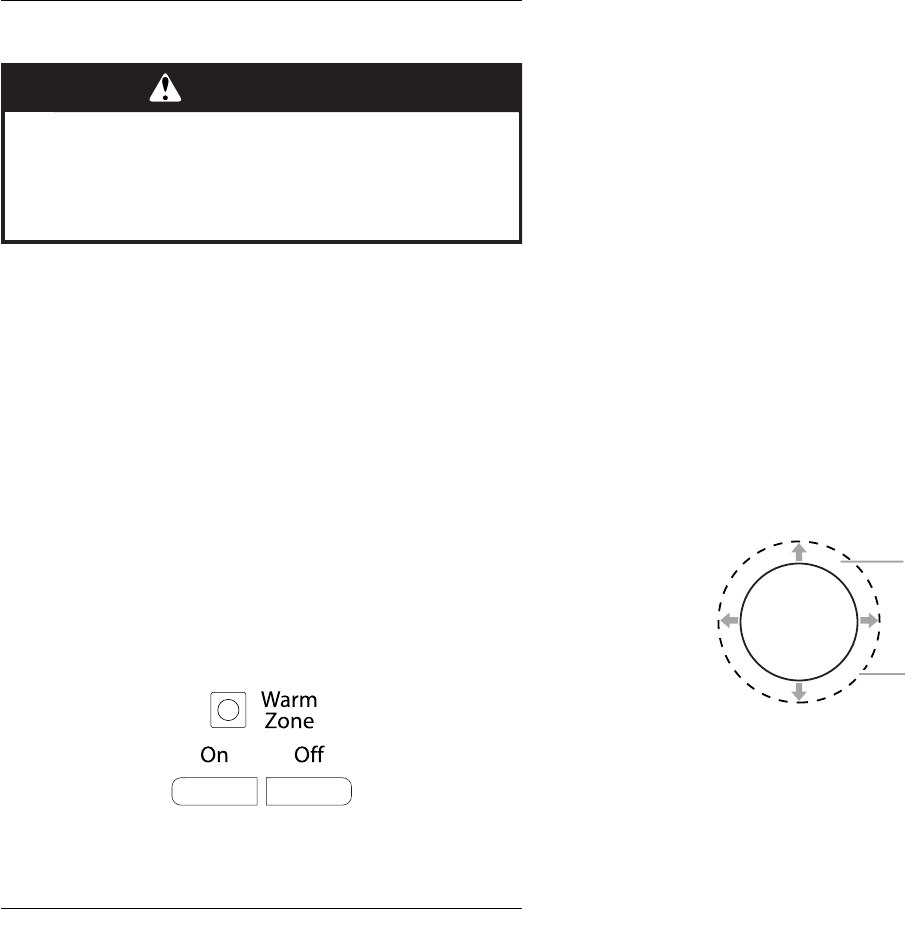
6
To Use Single Element:
1. Push in and turn the control knob counterclockwise from the
OFF position to the Single zone anywhere between HI and
LO.
2. Push in and turn knob to OFF when finished.
To Use Dual Element:
1. Push in and turn the control knob clockwise from the OFF
position to the Dual zone anywhere between HI and LO.
2. Push in and turn knob to OFF when finished.
Warm Zone
Use the Warm Zone element to keep cooked foods warm.
One hour is the recommended maximum time to maintain food
quality.
Do not use it to heat cold foods.
The Warm Zone element can be used alone or when any of the
other surface cooking areas are being used.
The Warm Zone element area will not glow red when cycling on.
However, the Element On light will glow while the Warm Zone
element is in use. The Hot Surface light will glow as long as the
Warm Zone element area is too hot to touch.
■ Use only cookware and dishes recommended for oven and
cooktop use.
■ Cover all foods with a lid or aluminum foil. When warming
baked goods, allow a small opening in the cover for moisture
to escape.
■ To avoid damage to the cooktop, do not use plastic wrap to
cover food because the plastic wrap may melt.
■ Use pot holders or oven mitts to remove food.
To Use:
1. To turn on, press WARM ZONE ON. Then press START.
2. To turn off, press WARM ZONE OFF.
Ceramic Glass
(on some models)
The surface cooking area will glow red when an element is on.
Some parts of the surface cooking area may not glow red when
an element is on. This is normal operation. The burner will cycle
on and off to maintain the selected heat level. It will also
randomly cycle off and back on again, even while on High, to
keep the cooktop from extreme temperatures.
It is normal for the surface of light colored ceramic glass to
appear to change color when surface cooking areas are hot. As
the glass cools, it will return to its original color.
Cleaning off the cooktop before and after each use will help keep
it free from stains and provide the most even heating. On
cooktops with light colored ceramic glass, soils and stains may
be more visible, and may require more cleaning and attention.
Cooktop cleaner and a cooktop scraper are recommended. For
more information, see “General Cleaning” section.
■ Avoid storing jars or cans above the cooktop. Dropping a
heavy or hard object onto the cooktop could crack the
cooktop.
■ To avoid damage to the cooktop, do not leave a hot lid on the
cooktop. As the cooktop cools, air can become trapped
between the lid and the cooktop, and the ceramic glass could
break when the lid is removed.
■ For foods containing sugar in any form, clean up all spills and
soils as soon as possible. Allow the cooktop to cool down
slightly. Then, while wearing oven mitts, remove the spills
using a scraper while the surface is still warm. If sugary spills
are allowed to cool down, they can adhere to the cooktop
and can cause pitting and permanent marks.
■ To avoid scratches, do not slide cookware or bakeware
across the cooktop. Aluminum or copper bottoms and rough
finishes on cookware or bakeware could leave scratches or
marks on the cooktop.
■ Do not cook popcorn in prepackaged aluminum containers
on the cooktop. They could leave aluminum marks that
cannot be removed completely.
■ To avoid damage to the cooktop, do not allow objects that
could melt, such as plastic or aluminum foil, to touch any part
of the entire cooktop.
■ To avoid damage to the cooktop, do not use the cooktop as a
cutting board.
■ Use cookware about the same size as the surface cooking
area. Cookware should not extend more than ½" (1.3 cm)
outside the area.
■ Use flat-bottomed cookware for best heat conduction and
energy efficiency. Cookware with rounded, warped, ribbed or
dented bottoms could cause uneven heating and poor
cooking results.
■ Determine flatness by placing the straight edge of a ruler
across the bottom of the cookware. While you rotate the ruler,
no space or light should be visible between it and the
cookware.
■ Cookware designed with slightly indented bottoms or small
expansion channels can be used.
■ Make sure the bottoms of pots and pans are clean and dry
before using them. Residue and water can leave deposits
when heated.
■ To avoid damage to the cooktop, do not cook foods directly
on the cooktop.
WARNING
Food Poisoning Hazard
Do not let food sit for more than one hour before or
after cooking.
Doing so can result in food poisoning or sickness.
A.Surface cooking area
B.Cookware/canner
C.½" (1.3 cm) maximum overhang
A
B
C



